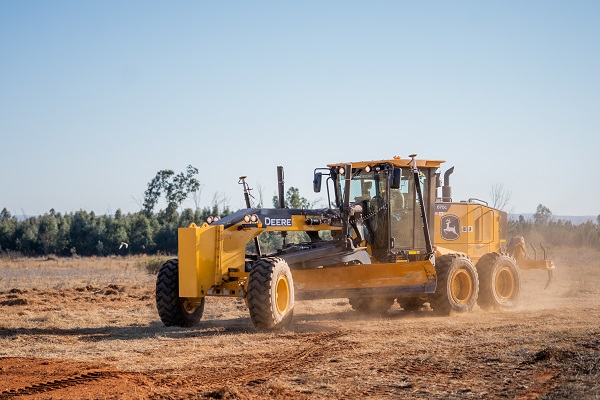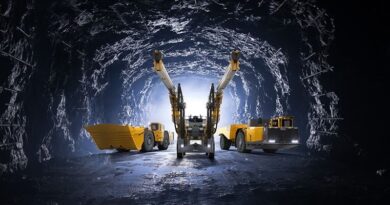Truly John Deere motor graders – since 1967
John Deere, primarily known for its green machines, announced in 2021 that it was bringing its construction and forestry lines back under the John Deere brand in its Africa and Middle East branch. This meant that it was the first time John Deere machines were sold under its own name in 18 countries in Africa. Construction World spoke to Griffiths Makgate, Sales Manager, John Deere Construction & Forestry Africa and Middle East about the brand’s motor graders, the options customers have for choosing the best model for the job at hand, and how John Deere’s after-market support assists customers to successfully navigate an industry with its wafer-thin margins.

“Our motor graders have earned the reputation that they have exceptional control and offer grading precision through the Customer Advocate Group-tested dual-joystick control,” he explains.
Evolution of the John Deere motor grader
The current range of motor graders is the result of the evolution of John Deere’s motor graders that started in 1967 when the JD 570 motor grader was introduced. “This machine was easlily identifiable with its scarifiers positioned in front while the scarifiers – or rippers as we now refer to them – are at the back of current machines,” says Makgate.
With this motor grader, John Deere produced the world’s first articulated-frame grader, the JD570. The articulated frame steering reduced the turning radius and enabled the grader to bend in the middle in order to put the front wheels over a windrow, on a slope or down a ditch while keeping the rear wheels on solid footing. Hereafter John Deere motor graders evolved to include six wheel drive to enhance traction control for the tough conditions it often operates in and to achieve maximum precision,” says Makgate.
John Deere allows operators to achieve the next level in grading performance because it provides stability for the operator to maintain levels. “This is achieved with the current John Deere PowerTech™ engines and the PowerShift PlusTM transmission, with the Autoshift Plus function that removes the need to use the inching pedal. It provides the benefits of a torque converter to the operator but retains all the performance benefits of the direct drive transmission,” Makgate explains.
“Some motor graders require the operator to go back to neutral to get to reverse. John Deere motor graders enable you to flip directly to reverse from forward while in the same gear (gateless shifting) –minimises stopping to select direction and the desired gear,” says Makgate.
Seeing profitability
He says this evolution has now reached the cab. “It’s a low profile cab that is designed to make sure that you have expansive visibility. “The operator has to see all four sides as you not only need to see your environment, but also the tip of both ends of the blade.” This all-round visibility is virtually unobstructed and the cab offers a clear view of the heel and toe.
As seat comfort for the operator is vital to ensure maximal production, an air suspension seat negates the vibration in the operating conditions.
Operating the John Deere motor graders is further enhanced by an LCD high-visibility monitor and smooth gateless shifting of gears.
“Productivity starts with the comfort inside the machine,” says Makgate. “This ensures that the operator can function for hours as the air suspension seat and air conditioning, that comes standard in cabs across the range of graders, enable this.”
Maximal productivity is also achieved by the precision that John Deere graders offer as it enables the operator to achieve accuracy sooner with less time spent going forwards and backwards to achieve levels and finish. “The tolerances of the circle in the A frame are quite small and accurate, so the productivity of John Deere machines also begins from the mechanics of the grading components,” says Makgate.
Choose how you work
Makgate says that customers choose the grader that best suits the production at hand. “The choice depends on the material to be moved, general application of what the grader is purchased for and the width of the blade.” John Deere has various models in its motor grader line-up ranging from the 620 G/GP grader which is a maintenance grader, the 670 G/GP, the 770 G/GP and the 870 G/GP. The latter is the biggest machine on offer and used for major infrastructure projects where precision is key.
“John Deere also offers six-wheel drives. It’s the same model, but with a two at the end (622, 672, 772 and 872). We also offer graders at the higher end in terms of technology and spec. It’s the same model but with GradePro options (the GP at the end),” explains Makgate.
He says that the lead time with highly specced machines can be up to six months as they are sourced from either Brazil or the USA, but that those machines that have standard specs are normally in stock locally. Of these, Makgate says that the 620G & 670 G/GP are the most popular models. “They can be configurated with a 12 or 14 foot blade.”
Keeping downtime down
For Makgate capability is not only about the physical machine that a customer buys. “John Deere’s capability is intricately linked to its footprint. If anything fails, it is vital to access that machine, no matter where it is working. We can easily reach a machine through our dealer network which is spread across the country,” he says. John Deere is supported in Southern Africa by AFGRI Equipment, Mascor and Senwes Equipment. These are well known names in the farming community, but since 2021 also delivers dedicated sales and service to the construction customer.
If a machine is sold to a customer by a certain branch, that branch has to have the special tools available to service the motor graders.. There is also a standard list of parts that the branch needs to keep in stock and if it does not have the part at point of need, the secondary plan is to get it from the closest branch, failing which it can be sourced from the Regional Parts distribution (RDC) in Kempton Park.
“Our after-sales support entails having technicians who can service the graders. This is backed by having spare parts available. If the technician encounters a problem that they cannot resolve, a technical adviser will investigate a solution. These advisors have access to a global system and can get a solution to resolve a problem in real time, 24 hours a day,” says Makgate.
Easy servicing is possible as the parts that need to be worked on are easily exposed by opening the side covers. “The tandem drive’s filters, engine oil, transmission, hydarulic and fuel filters are easily accessible. On John Deere graders, tandem drives are filtered,” Makgate adds.
Experience a demo
John Deere dealers in South Africa are running a demo programme to assist potential customers that want to buy a new motor grader.
“If a customer wants to experience a machine they are invited to request a demo model through AFGRI Equipment, Mascor and Senwes Equipment.”




